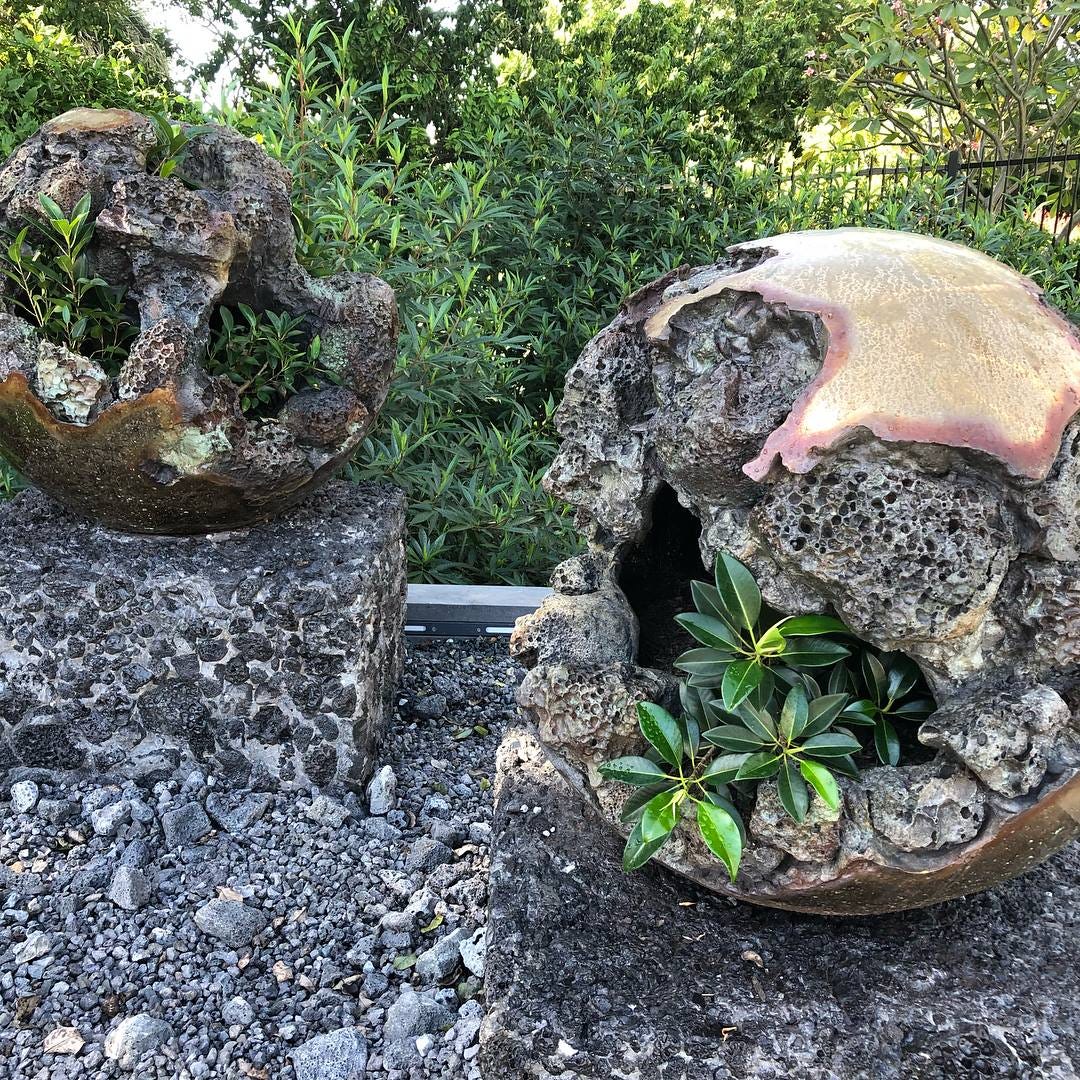A brief introduction to the sculptures of Jamie North
My essay on a little known Australian artist.
I still recall, vaguely, the first time I encountered one of Jamie North’s sculptures. My parents used to occasionally take me to the Mt Coot-tha botanical gardens when I was a kid, which is one of Brisbane’s most popular destinations, famous for its brilliant diversity of plants, its planetarium and geodesic dome, its Japanese garden and bonsai collection, and its lookout on top of a hill that allowed you to see most of the city of Brisbane. Truly a beautiful place. I always thoroughly enjoyed, and continue to enjoy, my visits to this wonderful man-made forest.
But among all these grand and well known features of that garden, there is a small detail to the place that captivated me also. Close to the information centre, besides one of the many footpaths, I once came across a pair of mysterious bronze balls, partially cratered and full of hollows, that housed a pair of Moreton bay fig seedlings. Their strange form, reminiscent of some beachside cliff full of hollows and rockpools, combined with their weedy occupants, inspired the same kind of admiration and wonder you may feel when exploring some old ruin covered in vines, or a hollow in a tree or cliff that has accumulated miscellaneous plants and animals. These two sculptures, number 20 and 21 of his “Remainders” series, were the first works of Jamie North I had seen. In the photo above you can see what they looked like when they were first installed in 2018, but currently the brass balls look more weathered, they are surrounded by low bushes, and their weedy occupants are much larger and taller than before.
Many years after my first encounter with his “Remainders 20 and 21” I encountered his work yet again in the “Air” exhibition hosted by the Qagoma (Queensland gallery of modern art). Just as with my first encounter, “Portals” was a pair of sculptures that sat side-by-side. They were two dark-grey concrete pillars, around 3 meters tall, with slanting hollow faces overgrown with ferns, vines and figs. Unlike the diminutive “Remainders” these sculptures were a towering presence, that seemed to be the broken and decayed pylons of some abandoned concrete building that had been overtaken by nature. Sometime after this I came across his Instagram account and his website, where I discovered more of his artwork. All of this has ensured that Jamie North is one of my favourite artists.
Most of Jamie North’s sculptures share the singular principle of housing plants, particularly Australian natives, within hollowed and cratered forms of bronze or concrete mixed with pieces of slag and other forms of mineral industrial waste. The sculptures usually take the form of balls or pillars, or just natural stones. The interaction of the natural and man-made is the major theme that the artist says his sculptures explore, inspired by the industrial ruins that he came across many times in his travels. Anyone who can look upon some old and decaying concrete building that has become overgrown with ferns, figs 1 , vines and weeds, yet find something beautiful about it, will understand and appreciate what this artist tries to evoke with his sculptures.
Due to the incorporation of plants into his sculptures, Jamie North deliberately ensures that they are dynamic rather than static works of art. The changing growth of the plants, combined with the subtle erosion and staining that repeated watering will create on concrete or bronze, ensures that his sculptures will never look exactly the same year after year. It would not be inaccurate to describe his sculptures as being large and glorified pot plants2.
An interesting aspect of his art that no one else seems to have mentioned, is that some of its aesthetic appeal and inspiration seems to share some similarities with the Chinese art of “Scholar’s stones”, and also some decorative elements used in the Japanese art of Bonsai. Both involve strangely formed stones, cratered, honeycombed and hollowed. But the later art seems to have a stronger relation to Jamie North’s work since it also complements static rock with growing plants, whereas scholar’s stones aren’t necessarily combined with plant life. I’m not suggesting that he was deliberately inspired by this traditional art form, but rather that a similar aesthetic appreciation of nature inspired their creation. One could also say that they are artistic predecessors to Jamie North’s sculptures. Another possible artistic predecessor to Jamie Norths work could be some of the artificial grotto art or “rustic” garden ornaments created in Europe during the renaissance and the enlightenment.
I shall finish off this essay with a few more photos of his art, and some links to his website and a few interviews he has given.
I am referring to the various weedy or parasitic trees that are often called “figs”, such as Moreton Bay figs, rather than the figs you eat.
I’ve wondered for a long time why neither Jamie North nor his fans have ever attempted to make money out of his art by producing plant pots/containers that mimic his most famous sculptures in miniature form. It would be fairly simple, for example, to produce small reproductions of his “Remainders” sculptures in either concrete, plaster of Paris, or recycled aluminium and sell them in small batches, just to test the waters and see if there is any large demand for such a novelty. If a sufficiently large demand exists, I could see Bunnings or Anko selling mass-produced copies. It could also be possible for anyone with a DIY inclination to produce their own copies of his work, either through a similar concrete mould or maybe even via ceramic reproduction or 3D printing.











These are really beautiful. Thanks for sharing this work.
I often knock modern art as a scam/con job compared to the older stuff. This is an exception. Beautiful